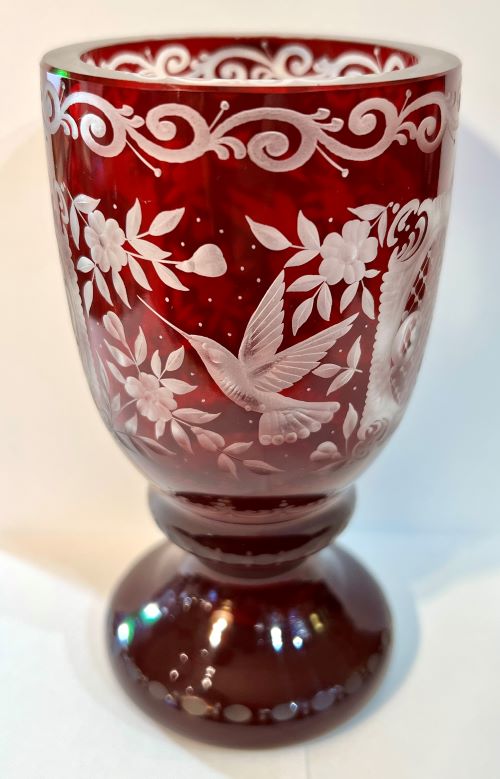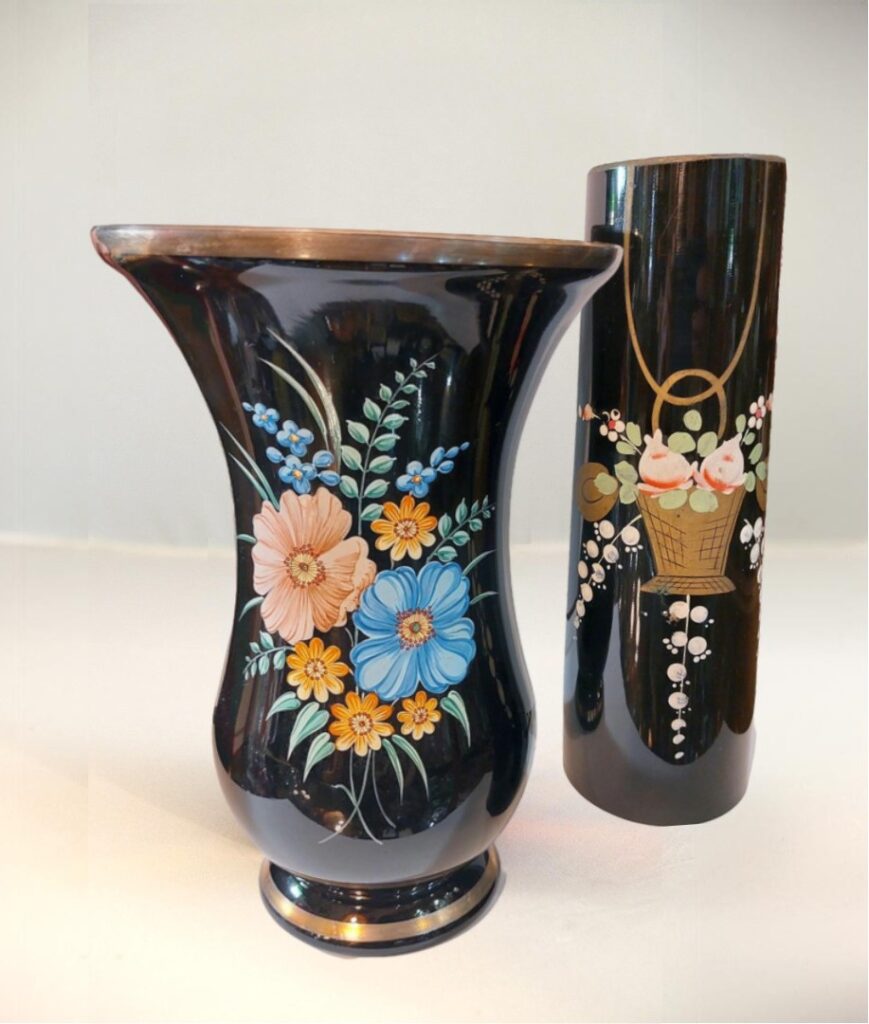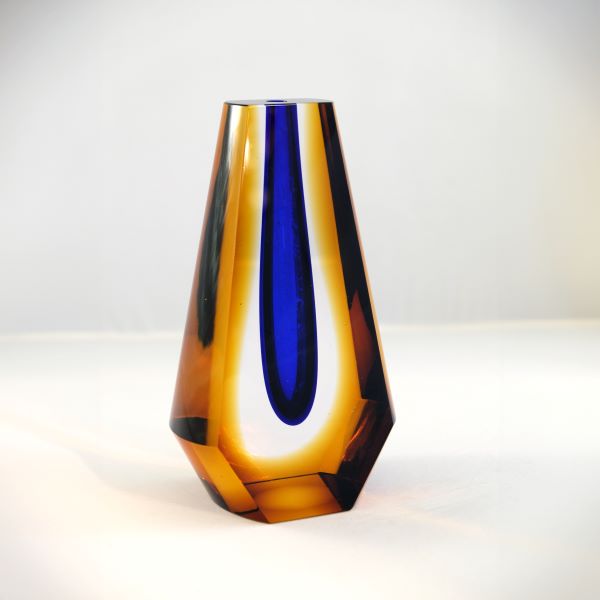History of Bohemian glass – if you are visiting Czech republic or you are an expat here, you have probably heard talk about Bohemian glass. Or more specifically about Bohemian crystal glass (this article focuses more on that) or about the uniqueness of glass in the Czech Republic / Bohemia. Bohemian glass is sought after by tourists. But they also seek out trdelníky.
Is is there really something specially about Bohemian crystal glass? And what is the history of Bohemian glass?

The beginnings of glassmaking
Glass, or glass beads, were already found in our territory in the Celtic period, but there is no indication that Celts produced glass. Rather, they obtained it in expeditions or by trade and then remelted it. It is highly unlikely that Celts knew how to make it.
The history of Bohemian glass is thus more likely to be linked to the Middle Ages, i.e. the 13th and 14th centuries, when windows (stained glass) for churches and cathedrals were the thing to get closer to God. But at that time glassmakers started to produce also glasses or bowls.
Very typical of this period is historic forest glass, which got its name because of its typical greenish colour and technique of production. And even though glass was only found among the nobility, this does not mean that it was not useful. It was ready for greasy hands, signing contracts and riding horses. (More on this period and forest glass here).
Though this was a period when the talk was mostly about Venetian glass, not yet the Bohemian glass. And especially about glass from Murano, the island where Venice had moved glass production due to fear of fires. And the poorer accessibility also made it easier to preserve the secrets of glassmaking technology. Speaking of secrecy, it was taken very seriously indeed – rumour has it that the monks in Murano who made the glass were ready to find and kill the monk if he escaped.
But back to the history of Bohemian glass. It first became known in the Middle Ages for the export of the rose quartz glass beads. Their production was cheaper (not so much wood was needed). And in addition, in Šumava they discovered a method of producing them in large quantities. Since, unlike blown glass, beads were easy to transport, there was nothing to prevent their export to what is now Spain.
Nothing, that is, except the Hussite revolution – a time of iconoclasm that slowed down and destroyed many craft workshops, including those of glassmakers.
The history of Bohemian glass is being written
After the Hussite Revolution, new Renaissance trends were finding their way to Bohemia only slowly. Venetian-type glass was in demand. And Bohemian glassmakers are adapting to this, as Venetian-type glass is a trend. Since, it is also necessary to produce glass locally, as export is too expensive. Transporting the fragile blown glass over bumpy roads in wheelbarrows (and later horse-drawn carts) increased the cost of transport. Glass therefore had to be produced locally.
The history of Bohemian glass in our area only gradually began to be rewritten during the 16th century. As technology progressively changed, innovations were made and new ways were found. The period of Rudolph II (2nd half of the 16th century) favoured skilful engravers – who spiced up Bohemia’s glass production.
But the real turning point was a new Bohemian unique – Bohemian crystal glass, which was discovered by French glassmakers who emigrated to the Bohemian lands because of the 30-year war. Thanks to its properties and skilled cutters and engravers, Bohemian crystal glass became a worldwide phenomenon in the 17th and first half of the 18th century (more here).
The golden era of history of Bohemian glass
In the 18th century, the Jizera Mountains and then Jablonec nad Nisou gradually became the world centre of the glass trade thanks to their craftsmanship and commercial skills. During the 18th and 19th centuries, companies in North Bohemia specialised in exports. And they did so well that there are even records of Czech glassmakers lending to the Spanish royal court.
Another milestone in the history of Bohemian glass which is also worth mentioning – the involvement of the nobility in the production – in the 1850s Count Kinsky founded the first manufactory in Sloup near Haida. And he was far from the being the only one.
This brought the opportunities to experiment more – to be unique and exceptional. Which was not always the success. This is how, for example, hyalite glass came into the world. It mimicked onyx or obsidian and couldn’t be shone through. The glass was thickened with crushed porcelain powder, but the production did not pay off.
It was extremely difficult to make the layers so that they were uniform and not translucent. The production was really difficult and expensive. And the same happened later on, when other companies tried to revive it. The closest available glass to this is burel glass (see photo), but this one produces purple reflections when illuminated.
And why all these efforts? Aside from the commercial spirit and the pursuit of uniqueness, the experimenter’s zeal, it’s good to remember that glass often replicated precious metals. But it was much cheaper and sometimes lighter as well. That is why crystal is called crystal, dark glass imitates obsidian, malachite glass had its golden era, etc.

Family clans and production centres
Glassmaking was passed down within families. So glassmaking was mainly dominated by family clans, a bit of a mafia, which gradually expanded from one place to another. Thus, in Haida (Nový Bor) and its surroundings there were about 330-350 glass workshops between 1890 and 1930. It was probably the highest density of glass workshops in the history of mankind.
One of the most extensive was the Rückl family or the Riedel family in the Jizera Mountains, which was also one of the most powerful and well-equipped. The families did not necessarily do everything themselves – they for example hired designers, who mostly worked as today’s freelancers.
Although we can talk about centres in the borderlands such as Haida, the Jizera Mountains, Šumava. Or important centres outside it, such as Světlá nad Sázavou, the history of Bohemian glass was written everywhere. Even in Prague where glass was for example made by the Order of the German Knights. Glassworks were also often part of monasteries, which traded among other glass. Glass was everywhere.
The Industrial Revolution and the modern history of Bohemian glass
Gradually we have moved into the Industrial Revolution of the history of Bohemian glass. This, of course, also had an impact on glass production. For one thing, it made production more efficient and cheaper, and this is perhaps behind the sustainable success of uranium glass (more about it here). And along with this to differentiate from other manufactures became increasingly important. This is why, in addition to new discoveries and experiments, family clans hired good designers and draughtsmen.
In fact, this trend has persisted to the present day – whether we’re talking about the success of Moser (more about their glass here), the completely new vision of the world after World War I. Or about metallurgical glass, which had its great renaissance in the 1960s (see this article). Like Bohemia crystal, each of these topics deserves its own article.
After World War II and Expo 58
For some time, it seemed that with the rise of communism, the history of Bohemian glass would be over. That the Art Nouveau period, the pre-war Moser, the uranium glass era, Karel Palda in the Art Deco period or the malachite glass of Ingrid were a beautiful and dignified end to the era that began with Czech crystal.
Companies were nationalised and it was impossible to create freely, everything was subject to central planning. People who didn’t understand what they were doing were put into management positions.
Fortunately, Expo 58 provided at least a partial change – because the communist regime decided to continue the glass tradition. And thanks to the desire to appeal to the West and the need for currency, it encouraged some Czech glassmakers to produce quality items.
And so, at least to a limited extent, small glass artworks and exhibition glass sculptures began to emerge again.

More about glass
Uranium glassware
Moser glass
How to recognize antique glass
Did you find glass objects in your grandparents’ attic, did you get your hands on an object that you think might be old and valuable? Or are you playing with…
Malachite glass
Bohemian crystal glass
Vintage metallurgical glass
The precisely engraved glass, the refraction of crystal glass, the timeless decors of art deco glass are amazing. But each of us at sometimes longs for an elegance that carries…









